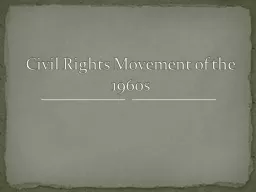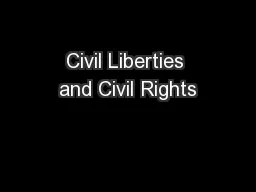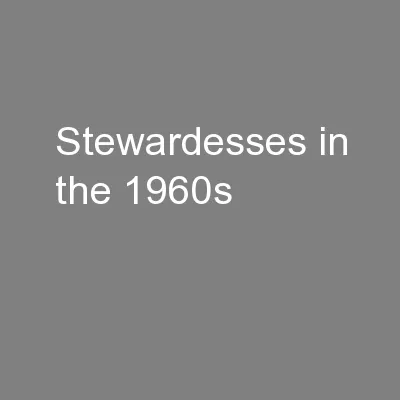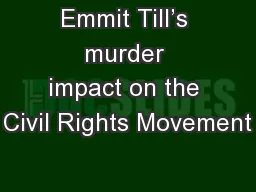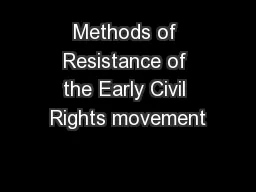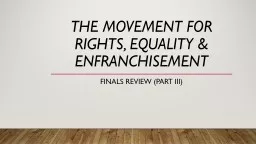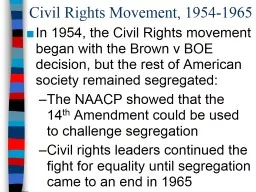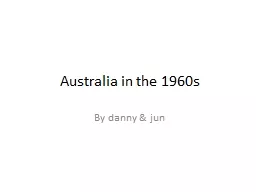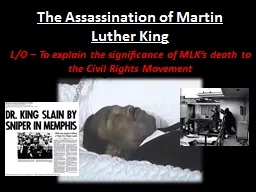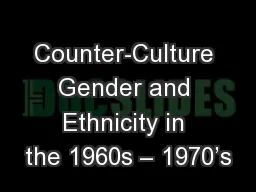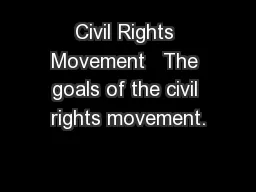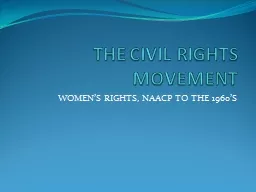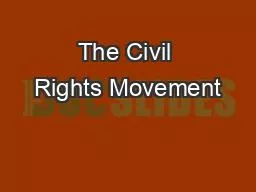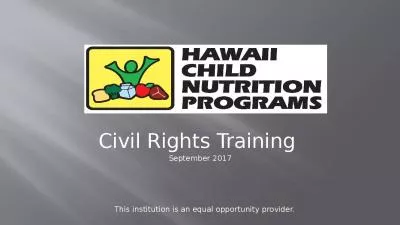PPT-Civil Rights Movement of the 1960s
Author : kittie-lecroy | Published Date : 2017-08-02
SSUSH21 The student will explain economic growth and its impact on the United States 19451970 b Describe the impact television has had on American culture include
Presentation Embed Code
Download Presentation
Download Presentation The PPT/PDF document "Civil Rights Movement of the 1960s" is the property of its rightful owner. Permission is granted to download and print the materials on this website for personal, non-commercial use only, and to display it on your personal computer provided you do not modify the materials and that you retain all copyright notices contained in the materials. By downloading content from our website, you accept the terms of this agreement.
Civil Rights Movement of the 1960s: Transcript
SSUSH21 The student will explain economic growth and its impact on the United States 19451970 b Describe the impact television has had on American culture include the presidential debates KennedyNixon1960 and news coverage of the Civil Rights Movement . D. awn . of a golden . age?. The Great . Society. During . his presidential campaign in 1960, John F. Kennedy had promised . the “. New . Frontier”.. . a package of laws and reforms that sought to eliminate injustice and inequality in the United States. . Introduction . Game Plan. This . week we will study one Amendment at a time, starting with the text of the Amendment and then following the Supreme Court (SCOTUS) cases that further explain that Amendment.. Outline. Thesis. Primary Sources. Secondary Sources. Coffee, Tea, or Me?. Conclusion. Thesis. Stewardesses as representatives . 2. Hiring standards . 3. Change . Primary Sources. -Memoirs:. -Airline Stewardesses:Glamour Isn’t Enough (1962). Thesis!!. The murder Of Emmit Till had a significant impact on Civil Rights Movement.. The murder Of Emmit Till had a significant impact on Civil Rights Movement.. Reasons. The murder enraged Blacks in the north and south.. Litigation . (court cases – i.e. Brown v. Board of Ed.). Boycotts . (Montgomery Bus boycott after the arrest of Rosa Parks). Blacks walked and carpooled to work for over a year until they reversed the segregation laws on Public Buses.. Finals Review (Part III). Reform Movements (1880 – 1920). Various social, political and economic problems sparked reforms and movements during this period:. Settlement House Movement. Square Deal Reforms. In 1954, the Civil Rights movement began with the Brown v BOE decision, but the rest of American society remained segregated:. The NAACP showed that the . 14. th. Amendment could be used to challenge segregation. By . danny. & . jun. Fashion . Hairstyles . In Australia, the 60’s wasn’t just introduced to major fashion changes, but were also introduced to new hairstyles. A popular hairstyle introduced during the 1960‘s was an up-do called the beehive. Originating in the United States during 1958 as one of a variety of elaborately teased and lacquered versions of “big hair” that initiated from earlier pageboy and bouffant styles. . L/O – To explain the significance of MLK’s death to the Civil Rights Movement. Political Assassinations of the 1960s. During the 1960s, several important US political figures were . assassinated. A Time of Social Change. Culture and Counterculture. The Main Idea. The counterculture that emerged in the 1960s and 1970s left a lasting impact on American life.. Reading Focus. What led to the rise of the counterculture? . - The goals were to:. desegregate schools, restaurants, buses and other public accommodations . to freely exercise the right to vote; . and to win protection against intimidation, harassment and violence — in general, to gain full and equal rights for African Americans. THE CIVIL RIGHTS MOVEMENT WOMEN’S RIGHTS, NAACP TO THE 1960’S THE CIVIL RIGHTS MOVEMENTS The women’s rights movement in the 1800’s laid the foundation for minority rights. The Civil War Amendments (pushed for by Frederick Douglas) passed by Abe Lincoln were the cornerstones. The Need For Change. - The white race deems itself to be the dominant race in this country…But in the view of the Constitution, in the eye of the law, there is in this country no superior, dominant ruling class of citizens…Our Constitution is color blind…In respect of civil rights, all citizens are equal before the law…. This institution is an equal opportunity provider.. Reason For Training: Ensures Civil Rights Are Protected . Ensures that program recipients are being treated without discrimination while participating in Child Nutrition Programs.
Download Document
Here is the link to download the presentation.
"Civil Rights Movement of the 1960s"The content belongs to its owner. You may download and print it for personal use, without modification, and keep all copyright notices. By downloading, you agree to these terms.
Related Documents

